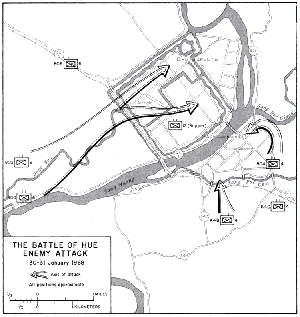
Home
FACs
More About FACs
The AO
A Shau Valley
• A Shau SF Camp
Hué
• Hué Cit Airfield
• MACV Compound
• LCU Ramp
• Hué Goose
Battle of Hué (Tet 1968)
• Trail FACs
The Missions
Visual Recon
• Sunken Sampan
Close Air Support
• CAS Munitions
• Rules of Engagement
• TACS
• Battle at Hua Cu
Interdiction
• McNamara Line
• Choke Points
Ranch Hand
Trail Dust Mission
Arc Light
SAR
Hammer 51 Rescue
Search for Jolly 23
• Msn Reports
• Search Area Map
• Search Rejoined
• Link to Past
Jungle Penetrator
Legacies
Aircraft
O-2A
Glossary
Resources
Contact
Return to Top
Return to Top
|

The Battle of Hué
Tet 1968
| |
As the ancient imperial capital and cradle of Vietnamese history and
culture, Hué stood as a tremendous psychological prize in the
struggle for control of that beleaguered country.
| |
In February 1966, at a strategy meeting in Honolulu, President Lyndon
Johnson asked his commander in Vietnam, Gen. William Westmoreland, what his
next step might be if he were the enemy commander.
"Capture Hué," General Westmoreland answered without hesitation, explaining
the city was the symbol of a unified Vietnam.
"Taking it would have profound psychological impact on the Vietnamese
in both the North and the South, and in the process the North
Vietnamese might seize the two northern
provinces as bargaining points in any negotiations."
Two years later -- almost to the day -- the enemy overwhelmed Hué and held
much of it for nearly a month.
The only combat troops to resist the initial assault were a depleted
South Vietnamese company.
The nearest U.S. troops were seven miles away.
|
|
|
George W. Smith,
The Siege at Hue
|
|
In the early morning hours of 31 January 1968, a division-sized force
of North Vietnamese Army (NVA) and Viet Cong (VC) soldiers launched a
well coordinated multi-pronged attack on the city of Hué.

Click on map for larger version.
(Map courtesy of
US Army Center for Military History)
Their targets were the Tay Loc airfield and the 1st ARVN Division
headquarters in the Citadel, and the MACV compound in the New City on
the south side of the river.
Their strategic objective, however, was to "liberate" the entire city
as part of a country-wide popular uprising to sweep the Communist
insurgents into power.
That never happened.
The people of Hué turned their backs on the Communists as did
people in other parts of Vietnam during the Tet offensive, and the
ensuing 26-day effort by the U.S. Marines, U.S. Army and ARVN to
recapture the Citadel produced a stunning military defeat for the
invaders.
Yet the strategic victory ultimately went to the Communists.
The scenes of bloody fighting in Hué, Saigon and other cities in
Vietnam during the Tet offensive so shocked the American people that
the pressure to withdraw from the war became overwhelming.
The stage was set for the ultimate Communist victory in 1975.
There are many excellent detailed accounts of the Battle of Hué available on-line.
Click on the following titles below for more information on the battle:
US Marines in Vietnam, 1968: The Defining Year
By Jack Shulimson, Lt Col Leonard A. Blasiol, USMC, and Charles R. Smith
Chapter 9: The Struggle for Hue-The Battle Begins
Chapter 10: The Struggle for Hue-The Second Phase
Chapter 11: The Struggle for Hue-Stalemate in the Old City
Chapter 12: The Struggle for Hue-The Taking of the Citadel and Aftermath
The Battle for Hue, 1968
by James H. Wilbanks
Block by Block: The Challenges of Urban Operations, Chapter 5
U.S. Army Command and General Staff College Press, 2003
War in the Northern Provincies
by
Lieutenant General Willard Pearson, USA (Ret)
"Isolating the Urban Area: Hue, Vietnam - January to February 1968"
Urban Operations, US Army FM 3-06, Chapter 6 (2003)
"Tet Offensive: Battle for Hué"
James M. Mueller, Vietnam Magazine, February 1997
(This first-person narrative describes the battle at and around the MACV compound)
Trail FACs During the Battle of Hué
After the initial attack in the early hours of 31 January 1968, the Trail FACs were trapped in the
MACV compound and cut off from their
airplanes at the Tay Loc (Hué Citadel) airfield across the river.
The airplanes (four 0-1s and four brand new O-2s) were destroyed with satchel charges during the attack. Click below to learn more about how some of the Trail FACs made their way out of the compound and rejoined the fight for Hué.
Trail FACs During Tet
Hué
MACV Compound
LCU Ramp
|
|
|


